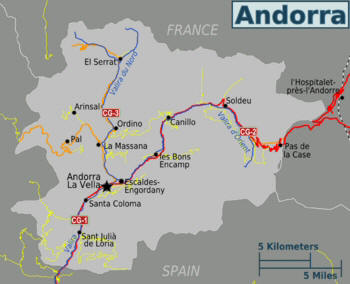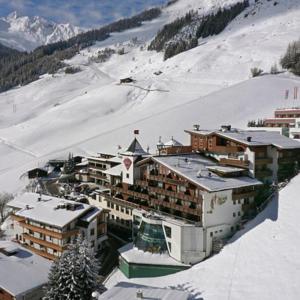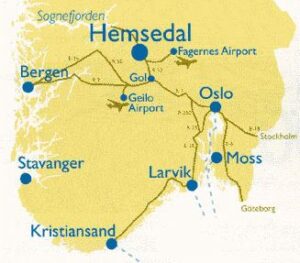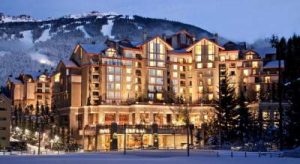Winter Ski Holidays from Take A Break Holidays
Winter Ski Holidays for your next skiing vacation trip. list of advice for a new skier. Tips for your first time winter skiing holiday.
Listing of over 100 places of accommodation in Andora Take A Break Holidays in Andora.
Due mainly to the mountainous nature of Andorra, there is only one road entering Andorra from France, and only one widely-used road entering Andorra from Spain. Almost all entry into the country happens at one of these two points.
Visitors from outside the EU should note that Andorra is not a Schengen member, and exiting France or Spain into Andorra will (theoretically) terminate a single-entry visa. In practice, though, immigration does not enforce this.
There are 8,855 properties in the Austrian Alps for your forthcoming stay.Hotels Apartments and Lodges for your next Skiing Holiday in Austria
Austrian Alps Austria Click in and choose your next Vacation. Sorry but you will be Spoilt for choice. Think of the numerous possibilities for a skiing holiday in Austria, at top resorts like Amadé, Niederau and Zugspitz Arena. Choose a cozy holiday home in a ski resort in Austria and you can have the ski vacation you’ve always dreamed of.
Tips for your first time winter skiing holiday (and instructors of first-time skiers)
Skiing is not a sport for everyone, there are many who simply won’t enjoy it. However, many people who try skiing once and then never again were not given a fair chance, because they were brought by a “friend” who probably made no serious effort to give them the basic information they needed to avoid being miserable.
Hemsedal Hallingdal Norway Take A Break Holidays
Hemsedal Buskerud county, Norway. It is part of the traditional region of Hallingdal. Hallingdal is one of Norway’s major valleys and a winter resort. It cuts through the bedrock for about 150 km from Lake Krøderen to Hardangervidda at Geilo
Here then is a list of advice for a new skier. It can also be used by would-be instructors to help you give a novice the best possible skiing experience.
Expectations
As a beginner, you should have reasonable expectations about your first day out. Hopefully, many of the things below will give you a better idea of what to expect. But there are some important basics to be prepared for.
You will fall down. A lot on a Winter Ski Holidays.
It is hard to get up, and this can be embarrassing.
There will be six-year-olds skiing circles around you, and this is infuriating.
You will be alternately bored and terrified, and not very often in between. Too slow and too fast are right next to each other for beginners.
The good news is that after the first day or two, most of these problems go away. And even on the first couple of days, you can still find a lot of space for enjoyment, but that depends on a host of other important details. How good or bad your first day is depends on understanding and following the advice below.
Whistler Skiing in Canada British Columbia
Whistler Skiing Whistler in Canada British Columbia The resort is comprised of two adjacent mountains, which are connected by the Peak to Peak gondola Its 8,100 acres of terrain receive an annual average of 360 inches of snow
Resort is divided into 15 percent beginner, 55 percent intermediate, 15 percent advanced and 15 percent expert trails. The resort boasts 12 bowls, three glaciers and more than 200 trails. Worth putting on your Bucket list
Boots on a Winter Ski Holidays
The biggest complaint of the complete novice is cold feet. Or sore feet. Or cut off circulation. This is because the boots you are using don’t fit. It is very important to get boots that fit, and not easy to do.
Boots should allow you to wiggle your toes. If you can’t wiggle your toes, then your feet will be cold. But, boots should not allow you to turn your foot side-to-side within the boot. If you can turn your foot inside the boot, you won’t have a chance to control your skis.
Of course, getting exactly between those two parameters generally requires your own boots, and a custom fit, so as a compromise, maybe you can wiggle your toes, but with effort. Or maybe your foot moves side-to-side, but only slightly. Try several pairs of boots your first time – not every boot marked the same size is actually the same size (even if they are the same brand and model). This extra effort will be annoying, but worth it.
Better yet, rent your equipment from a ski shop a day in advance of your first ski experience. You won’t feel rushed, and they should have a wider variety of boots to let you try, as well as much better advice about fit.
Socks on your Winter Ski Holidays.
Properly fitting ski boots are warm. Very warm. Completely warm. Do NOT wear very thick socks, or more than one pair of socks inside your boots. If you are too stuffed with socks, you’ll lose circulation and your feet will be cold (again, make sure you can wiggle your toes).
If you didn’t rent your boots in advance, finding a good fit will be a problem. Socks can help here. Bring two pairs of socks for your first outing, a thin pair, and a medium-thick pair. Then choose the socks based on how the boots seem to be fitting. You may even find you wear a thin sock on one foot and a thicker sock on the other, because the boots won’t match exactly.
Clothing on a Winter Ski Holidays
Do NOT wear jeans, or sweatpants. You will be falling down in snow, and even if it is cold enough to be dry snow, some of it will stick to you and melt. If you get wet, it’s over. There’s no chance to stay warm.
At least wear shells (nylon waterproof pants with no padding or insulation). But I recommend thick ski pants for beginners. This is for the padding more than for the cold. A beginner will fall enough that even if the snow is soft, they may get bruised without padding. The ski pants will also help keep your butt warm on the lift.
Similarly, your jacket should also be waterproof. It doesn’t matter how heavy it is. Just wear layers. That way you can add or remove layers as needed. I also recommend a zippered jacket, not a pullover. If you can open the jacket when you’re hot, then you won’t sweat too much (if you sweat too much, and then get cold, you’ll never be warm again).
Gloves must also be waterproof. If they are lightweight gloves, you’ll probably want a liner. If gloves are too tight, it will reduce circulation and your hands will be cold. Some heaver gloves may start tight, and then open up as the insulation stretches. I’ve found that using liners for a few minutes to start, and then removing them can stretch gloves open so that they are warmer.
Helmet on a Winter Ski Holidays
When I originally wrote this, helmets were not very common on the ski slopes. I’d generally only see the racers wearing them. We never wore helmets, even after I witnessed a friend having seizures on the slopes after falling and hitting is head on some ice. Even after Sonny Bono died on the slopes. And more recently, Natasha Richardson died of a head injury sustained during a fall which did not seem unusually hard.
Now (in 2012), things have changed. Helmets are becoming standard equipment. A helmet will protect your head, protect you from seizures, protect you from death, keep your head warm, and because they’re much more common, you won’t look like a dork. So wear one.
Keeping Warm on a Winter Ski Holidays
Keeping warm isn’t hard. Make sure you read the sections on boots, socks, and clothes above. Aside from this, to keep warm you have to wear the right amount of clothing, and keep moving.
First, start out warm. When you go out into the cold, you should be a little too warm, not quite sweating but close. Then the cold will feel good to you for the first minute or two. As you start to feel cooler, start moving. The colder you are, the more you should move. When I get particularly cold, I just push myself around the flat areas at the top or bottom of the slope with my poles. Just a minute or two of this should be enough to get you very warm, if you are dressed properly.
You may be warm in general but cold in spots. For the toes, wiggle them while you are waiting in line. Do the same for the fingers, and also flex your wrists. For neck, chin, nose, and especially ears, the rule is to simply keep them covered. If your body is warm but these parts are cold it is almost always because you left them completely bare.
Getting too hot can be a problem too. If you are sweating a tiny bit that’s fine. If you are sweating a lot, you are too hot. Your sweat will make parts of you very cold, even while other parts are still too hot. To deal with this, don’t be afraid of opening your coat, or removing your hat or gloves, for just a minute, or for the day. If your parent worried too much about this, you might find it tough to do, but trust your body — if it is hot, you need to cool it. (This kind of exposure will NOT cause you to catch a cold. It will aggravate an existing condition, but if you have a cold, what are you doing on the ski slopes?).
How much clothing is a tough call, and you have to learn from experience, because everyone’s body deals with heat differently. It will depend on how hard you are working, how windy it is, whether it is sunny or cloudy, wet or dry. Still, I’ll try to give you a rough starting point for a few different temperature ranges.
35-40 and sunny on a Winter Ski Holidays
You’ll be very warm as long as you keep moving. light sweatshirt or heavy long-sleeve tee-shirt may be all you need under your jacket. Just shorts or light sweats under your ski pants. The heavy ski pants will be too hot, but your first day you’ll want the padding. Lightweight gloves. Probably no head covering needed.
25 and sunny/30 and cloudy/35 and cloudy and very windy
Thermal shirt, medium sweatshirt, zipper jacket on top. sweats and ski pants on bottom. Cover your ears with a headband. Medium gloves.
10-15 and cloudy on a Winter Ski Holidays
Thermal shirt, warm sweater, jacket on top (or, three thin layers under the jacket). Thermal underwear, light sweats, ski pants on bottom. Cover your ears, neck, and chin.
10 below zero and windy
Thermal shirt, light sweatshirt, medium sweater, jacket on top. Thermal underpants, cotton shorts, warm sweats, ski pants on bottom. Thickest good quality gloves. Ski goggles. Ears, neck, chin must be covered. Must have something you can pull up over your nose. Head should be covered, but with something that you can remove and still have your ears covered.
Friends
This is the most important decision you’ll make for your first skiing experience. Find someone who is willing to go to the ski slopes and blow off a day of their own skiing enjoyment in favor of helping you out. This is hard to do. Find someone with inexhaustible patience. This is also hard to do. If you are comfortable with the notion, maybe you can just go by yourself. Better yet, go with someone else who has never skied (and share the information here with them). They should be someone with similar patience and temperament, as well as similar fitness and athletic ability. Misery loves company.
Instruction on a Winter Ski Holidays
If you happen to find that friend who will stick by your side all day and has inexhaustible patience, you’re off to a good start. They also have to be able to teach you how to ski. Some very good skiers are completely intuitive, and have no concious idea of how it works. You can find this out in advance by asking them for a dry skiing lesson, in your living room. If they seem confused or unsure, find someone else. (You will benefit greatly from a good dry lesson in advance. I’ll also try to explain a little bit of how to ski later on, so you can think it through.)
If your friend is not perfect, I’d recommend paying for a lesson. Group lessons are fine if you are naturally athletic, otherwise get a private instructor so you can go at your own pace.
Falling (and getting up) on your Winter Ski Holidays
As I said before, you will fall. If you happen to have any control over your fall, try to fall uphill. Try to land on your butt. Try to make your fall like a feet-first baseball slide.
The hard part is getting up. Now the irony here is that the steeper the hill is, the easier it is to get up (because you have less far to go). The problem is that the boots keep you from flexing your ankles, so you can’t get your legs under you very well.
Get your feet downhill from you, and tuck them as close to your butt as you can. Then push yourself up onto your feet in a squatting position (use the poles if you have to) and then stand up. If you have a few frustrating failures, let your friend or instructor help you up — you’ll get plenty more opportunities to get up later, and the frustration can be the biggest enemy.
Terrain
It is important to choose a ski resort with a good beginner’s area. The best thing to do is ask ski shops. You can’t call the resorts and expect honest answers. You want wide, not very steep slopes. And more than just one “bunny hill”, so you can work your way up gradually.
Conditions
Check ahead for the snow conditions. If they are icy, don’t even waste your time. Ice is hard packed snow that has melted somewhat on top and then refrozen, and will make a beginner fall every time. More importantly, when you fall, it will hurt because the ice is hard. A high of 25 the day after a snow storm should produce wonderful skiing conditions. A high of 25 the day after a rain storm should be avoided at all costs.
The Snowplow
The snowplow is the basic technique taught to beginning skiers. Unfortunately it is also a cruel joke, because it’s easy to do incorrectly. You’ll be told to point your skis towards each other. Predictably, the first thing that happens next is that the skis move towards each other, and cross each other, and you get tangled up and fall down.
What is often not explained very well, and is hard to do regardless, is to tilt your skis inwards towards each other. To do this, you have to pull your knees together, and continually push your feet apart. If that doesn’t make sense, think of the bow of a boat: the sides are angled in towards each other (i.e. towards the bottom of the boat), and they push the water apart. Of course, you can’t possible tilt your skis nearly as much the sides of a boat, but without some tilt, you won’t have any control over your speed, or your direction — you’ll skid sideways, do the splits, and cross your skis. My suggestion is that you work with someone that knows what they’re doing before you hit the slopes, so you can at least have a basic notion of how to proceed once you’re on snow.
Stopping
You should also know the reason why you have to snowplow. It controls your speed. As your skis become more parallel, you go faster. The more you snowplow, the more you are pushing your skis sideways across the snow. This makes you slow down. In order to stop, just snowplow more widely and with more tilt. How well this works depends on how steep the slope is, how icy, wet, or dry the snow is, and how strong and flexible you are.
Turning
Turning is particularly hard to explain, because so many skiers (myself included) do it intuitively — you just turn your body. But I think I can explain the basics.
First you will always turn with more weight on the outside foot (e.g. on a left turn, your weight is on your right foot). So shift your weight to the outside foot – one way to do this is to slightly lift your other foot (not off the ground, just put less weight on it).
Second, turn your body in the direction of the turn. Huh? But how you say. Try this experiment. Stand up, on one foot, and twist your body. (If on your right foot, turn your body to face left). You can probably do this intuitively. If you pay attention, what you do is lift the heel, and turn on the ball of the foot. On skis, you should also have the weight on the ball of the foot to turn, although the rear of the ski won’t actually lift off of the ground. Because of the skis, you’ll have to do the twisting motion a little more agressively than when standing on one foot, but it is the same basic motion.
Improvement
How fast you improve will depend on your fitness, and natural ability. But for most people, the first two days (three to five hours per day) will be rough, but after that you’ll really start to feel you’re getting the hang of it. One important factor is that you’ll ski worse when you’re tired. So if you start out on the second day feeling like you’re improving, but then by the end of the day you’re falling more than ever, it is because you are tired, not because you’re not learning.
Summary for Winter Ski Holidays
It’s important to have good conditions your first day. And take things at your own pace. You may at the end of the day still find that you don’t care for skiing. But if you follow all of the advice above, you’ll at least know you’ve given your winter skiing holiday a fair shake.
Did you know ‘Accommodation‘ is one of the most misspelt words in the English language? Here are some variations:
Accomadation, Accomodation, Acommodation.
Also Bed Breakfast Bed and Breakfast B&B BB or BnB details for your next vacation local information guide. B and B is an English traditional holiday idea, often hard to find in some parts of the world.
Take A Break Holidays takeabreakholidays, Winter Ski Holidays Accommodation.
Optimised June 5 P 89/92 H 74 FK 100 f ok
San Francisco De Asis, Urb Marina, San Fulgencio, 03177, Alicante, Spain2345
Site Disclaimer
Disclaimer: Whilst every effort has been made to provide accurate information, no liability will be accepted for misinterpretation, misrepresentation, errors or omissions - the information provided by our Websites is for use as a guide only and is issued in good faith as information All photographs images and video material is subject to the understanding that as they are in the public domain they can be used and shared as seen to be appropriate and unless they show a sign that they are covered by copyright law. This also covers Social media operations.1999---2023




